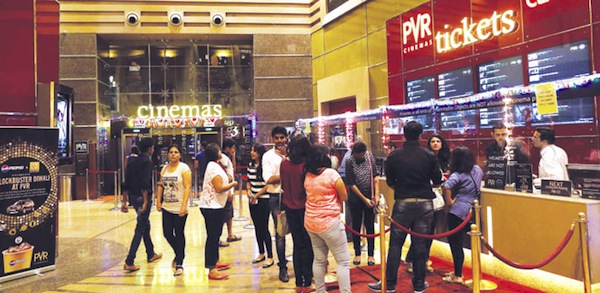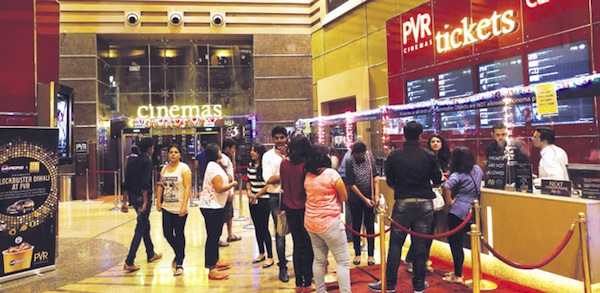Multiplexes Strike Gold in Movie-Mad India
For a country that produces twice as many movies a year as Hollywood, India has a problem that’s making cinema theatre operators beam: a shortage of modern multi-screen cinemas and plenty of increasingly affluent film fans.
 Cinema-goers wait to collect their tickets at a PVR Multiplex in Mumbai. Multiplex operators like PVR Ltd, Inox Leisure, Reliance Mediaworks and Mexican chain Cinepolis are scrambling to set up theatres targeting the rapidly growing number of middle-class Indians willing to pay to watch Bollywood movies in more comfortable surroundings. Reuters/Mumbai
Cinema-goers wait to collect their tickets at a PVR Multiplex in Mumbai. Multiplex operators like PVR Ltd, Inox Leisure, Reliance Mediaworks and Mexican chain Cinepolis are scrambling to set up theatres targeting the rapidly growing number of middle-class Indians willing to pay to watch Bollywood movies in more comfortable surroundings. Reuters/Mumbai
Multiplex operators like PVR Ltd, Inox Leisure, Reliance Mediaworks and Mexican chain Cinepolis are scrambling to set up theatres targeting the rapidly growing number of middle-class Indians willing to pay to watch Bollywood movies in more comfortable surroundings.
These plush theatres, often in big city shopping malls, are a far cry from the single-screen cinemas most Indians still frequent and which range from huge, purpose-built halls to sheds where the deluxe seats are wooden benches.
The potential is huge, provided operators can find the right location in a country where prime urban real estate is costly and in short supply.
Multiplexes account for just 8% of India’s 12,000 screens but rake in a third of total box office receipts, according to the Single Screen Association of India and a report by consultants KPMG and the Federation of Indian Chambers of Commerce and Industry (FICCI).
Averaging Rs160 ($2.60) each, tickets at Indian multiplexes cost almost three times more than a ticket at single-screen cinemas, the KPMG-FICCI report said. At the Inox multiplex in a prime Mumbai area, tickets for a recent showing of blockbuster Krrish 3 sold for as much as Rs380 ($6.10) each.
“Indians love their movies, their Bollywood stars and the middle class is increasingly ready to spend on a better movie-watching experience,” said Pramod Arora, president of India’s biggest movie theatre operator PVR, which expects revenue growth of 25% a year for the next three years.
By comparison, KPMG forecasts overall film industry revenues to grow 10.8% a year through to 2017.
“We want to grow in the bigger metro areas as they have limited real estate available and we want to capture all that first because that represents the prime consumption story in this country,” Arora added.
Multiplexes made it to India with the advent of modern shopping malls in the past decade or so.
PVR set up India’s first multiplex in 1997. Last year, it acquired rival Cinemax and has seen its share price double this year. India has just eight screens per million people, far less than the 117 per million in the US and 31 per million in China, according to the KPMG-FICCI report.
PVR runs 398 screens and plans to open another 300-360 in the next three years. Cinepolis, the world’s fifth-largest operator, plans to have 500 screens in India by the end of 2017 from 68 now.
Finding the right location, however, is a challenge for multiplex operators as mall development slows along with the economy. Economic growth this fiscal year is expected to be well below the decade-low rate of a year ago.
“We haven’t grown at the pace at which we would have liked,” said Cinepolis country head Ashish Shukla.
“We entered Brazil later and we are already three times the size of what we are in India because the development of real estate hasn’t been as per the commitment made to us,” he added. Cinepolis began operating in India in 2009.
Debt is another issue for the industry. PVR is the most leveraged of the listed Indian multiplex operators, according to Thomson Reuters StarMine data, with Rs6bn in debt for a debt-equity ratio of one.
“Once the free cashflows are higher than the need for us to grow then obviously we will retire the debt,” Arora said. “In the next 4-6 quarters we should be coming to that stage provided we don’t get another good acquisition opportunity.”
Some investors, however, are cautious.
“The business model of PVR is reasonably good,” said R K Gupta, chief executive of Taurus Mutual Fund, which owns shares in the company.
“But debt is a big concern for the company and the industry in general. It is fairly high and if say for some reason several movies in a row flop then there might be concerns.”
Via : gulf-times.com
Connect With Us
Related Posts
- Real Estate Act comes into effect: 10 things you need to know about new law ( May 4, 2017 )
- Expats Living in Comfort – Hyderabad, India ( May 4, 2017 )
- MNC queue to Hyderabad grows longer; JP Morgan & IBM look for office space ( June 22, 2016 )
- An Apple in Hyderabad’s IT Garden: CEO Tim Cook’s big announcement Today ( May 19, 2016 )
- Hyderabad May get Disneyland Park ( April 22, 2016 )
- Indian Office Space Absorption Up 11% in Q4: Survey ( April 13, 2016 )
- Cognizant plans to add 8,000 people at Hyderabad facility ( March 9, 2016 )
- Ranked 139 in world, Hyderabad is Best Indian City to Live in ( February 24, 2016 )
- The Platina – Exclusive Commercial Space, Hyderabad ( February 19, 2016 )
- Apple, Inc set to open new $25 million Tech Center in Hyderabad, India by June ( February 16, 2016 )
Recent Posts
Recent Comments
Archives
- February 2018
- October 2017
- May 2017
- June 2016
- May 2016
- April 2016
- March 2016
- February 2016
- January 2016
- December 2015
- November 2015
- October 2015
- July 2015
- June 2015
- May 2015
- April 2015
- March 2015
- February 2015
- December 2014
- November 2014
- October 2014
- September 2014
- August 2014
- July 2014
- June 2014
- May 2014
- April 2014
- March 2014
- February 2014
- January 2014
- December 2013
- November 2013
- October 2013
- September 2013
- August 2013
- July 2013
- June 2013
- May 2013
- April 2013
- March 2013
- February 2013
- January 2013
- December 2012
- November 2012
- October 2012
- September 2012
- August 2012
- July 2012
- June 2012
- May 2012
- April 2012
- March 2012
- February 2012
- January 2012
- December 2011
- November 2011
- October 2011
- September 2011
- July 2011
- June 2011
- May 2011
- March 2011
- November 2010
- October 2010
- September 2010
- August 2010
- July 2010
- May 2010
- April 2010
- March 2010
- February 2010



Leave a reply